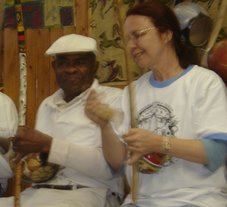Fortunately, I rarely throw anything away (though my cats have been known to do so inadvertently). I've found a 20-year-old notebook that I used when I was taking my first one-hand-washes-another Portuguese lessons from Moraes. It includes a short essay, written in Portuguese, that describes how we first met. Every detail matches my recollections, so there was little to correct in the previous entry, but the essay did remind me that the day after my fateful first visit to Fort Santo Antonio Alem do Carmo - now called the Capoeira Fort - I not only saw my first roda, but met Cobra Mansa, better known as Cobrinha. This is as good a place as any to say a few words about Moraes and Cobrinha, saving the great João Grande for later on.
Moraes told me that he was born on Ilha do Maré (literally "Island of the Tide") in All Saints Bay and later moved to Massaranduba, then an infamous slum on the outskirts of Salvador. When he did his obligatory military service, he joined the Marines and was sent to Rio de Janeiro. While there, he met Cobra Mansa, or Cobrinha. Moraes taught Cobrinha and others, like Mestre Braga, the form of Capoeira he had learned from João Grande at Mestre Pastinha's school in Pelourinho as a young man, and that is how the Grupo de Capoeira Pelourinho (GCAP) got its start in Rio.
When he returned to Salvador, Bahia, Moraes found that the older mestres were not being given their due, and Capoeira Angola was losing ground to the Regional style. With Cobrinha as his assistant, or contra-mestre, Moraes started teaching students and organising special bouts, or "rodas", for the "mestres antigos" who had trained alongside or under the late great Pastinha. Therefore, Moraes, Cobrinha and their students deserve most of the credit for the revival of Capoeira Angola that began in Bahia in 1981.
Friday, 20 July 2007
Subscribe to:
Post Comments (Atom)


No comments:
Post a Comment